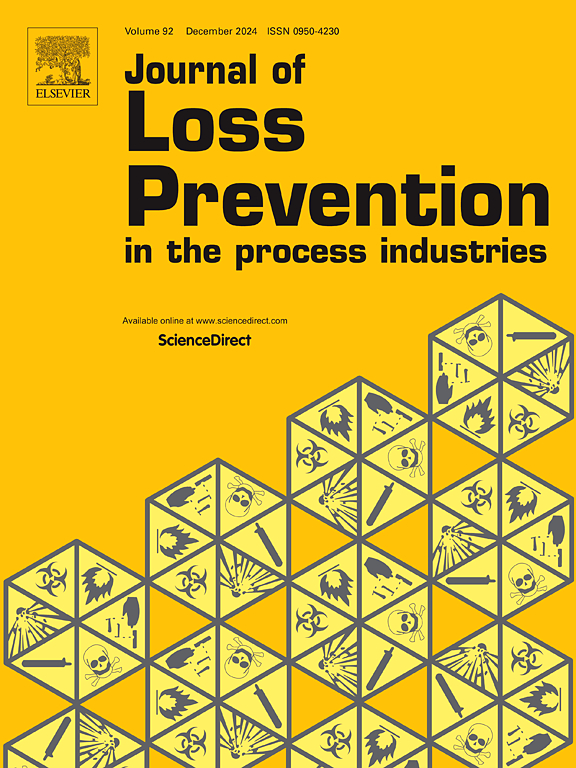CFD simulation of turbulent diffusion and phase transition of methanol spray in a 20L spherical vessel
IF 3.6
3区 工程技术
Q2 ENGINEERING, CHEMICAL
Journal of Loss Prevention in The Process Industries
Pub Date : 2025-04-23
DOI:10.1016/j.jlp.2025.105656
引用次数: 0
Abstract
The atomization process of flammable liquids occurs across various aspects of chemical industry production. Atomized droplets dispersed into the surrounding environment significantly enhance their risk, as the resulting fuel-air mixture requires minimal energy for ignition. Methanol, a widely used chemical feedstock, poses significant explosion risks due to its high volatility and flammability. The spray explosion behavior of flammable liquids is commonly studied experimentally using a standard 20L spherical explosion vessel. Recently, CFD simulations have emerged as a cost-effective and reliable approach for predicting particle behavior with high accuracy. In this study, the numerical simulation of methanol spray in a 20L spherical vessel utilized the DPM model. The continuous and discrete phases adhere to the Euler-Lagrange approach, employing two-way coupling and incorporating phase changes of methanol droplets upon entering the vessel. The numerical model was validated using experimental data of pressure and velocity variations over time. The spatial distributions of velocity, streamline patterns, particle trajectories, and turbulent kinetic energy (TKE) were examined under various ignition delay times. The correlation between the gas-phase methanol distribution after phase change and the temperature field was investigated. The results indicate that during the initial spray stage, the 20L spherical vessel exhibits a distinct spray diffusion behavior. Strong turbulence regions were observed near the nozzle outlet and in the central axis of the vertical jet. The TKE at the vessel center varied with ignition delay time, conforming to a Sigmoidal-Boltzmann fit. The gas-phase methanol distribution within the vessel exhibited a strong correlation with the temperature field. After 120 ms, both the gas-phase methanol distribution and temperature field achieved a steady state, with methanol droplets uniformly distributed and turbulence levels relatively low. Ignition at this stage can effectively prevent issues such as reduced fuel concentration and incomplete combustion resulting from uneven fuel-air mixing or droplet settling.
20L球形容器内甲醇喷雾湍流扩散与相变的CFD模拟
可燃液体的雾化过程发生在化学工业生产的各个方面。分散到周围环境中的雾化液滴大大增加了其风险,因为由此产生的燃料-空气混合物点火所需的能量最小。甲醇是一种广泛使用的化工原料,由于其高挥发性和易燃性,具有很大的爆炸危险。采用标准的20L球形爆炸容器对可燃液体的喷雾爆炸行为进行了实验研究。近年来,CFD模拟已成为一种经济、可靠、高精度预测颗粒行为的方法。本研究采用DPM模型对20L球形容器内甲醇喷射过程进行数值模拟。连续相和离散相遵循欧拉-拉格朗日方法,采用双向耦合,并纳入甲醇液滴进入容器后的相变化。利用压力和速度随时间变化的实验数据对数值模型进行了验证。研究了不同点火延迟时间下的速度、流线、粒子轨迹和湍流动能的空间分布。研究了相变后甲醇气相分布与温度场的关系。结果表明:在初始喷雾阶段,20L球形容器表现出明显的喷雾扩散行为;在喷嘴出口附近和垂直射流中轴线处观察到强湍流区。容器中心的TKE随点火延迟时间的变化而变化,符合Sigmoidal-Boltzmann拟合。气相甲醇在容器内的分布与温度场有很强的相关性。120ms后,气相甲醇分布和温度场均达到稳定状态,甲醇液滴分布均匀,湍流程度相对较低。这一阶段的点火可以有效防止由于燃料-空气混合不均匀或液滴沉降引起的燃料浓度降低和燃烧不完全等问题。
本文章由计算机程序翻译,如有差异,请以英文原文为准。
求助全文
约1分钟内获得全文
求助全文
来源期刊
CiteScore
7.20
自引率
14.30%
发文量
226
审稿时长
52 days
期刊介绍:
The broad scope of the journal is process safety. Process safety is defined as the prevention and mitigation of process-related injuries and damage arising from process incidents involving fire, explosion and toxic release. Such undesired events occur in the process industries during the use, storage, manufacture, handling, and transportation of highly hazardous chemicals.

 求助内容:
求助内容: 应助结果提醒方式:
应助结果提醒方式:


